2.5 Monitoring the Messaging Agent
By monitoring the Messaging Agent, you can determine whether or not its current configuration is meeting the needs of your Messenger users. You have a variety of tools to help you monitor the operation of the Messaging Agent:
2.5.1 Using the Messaging Agent Console on NetWare and Windows
The following topics help you use the Messaging Agent console on NetWare and Windows:
NOTE:The Messaging Agent console is not available on Linux. Use the Web console instead, as described in Using the Messaging Agent Web Console.
Monitoring the Messaging Agent from the Messaging Agent Console
The Messaging Agent console provides information, status, and message statistics about the Messaging Agent to help you assess its current functioning.
Figure 2-4 Messaging Agent Console
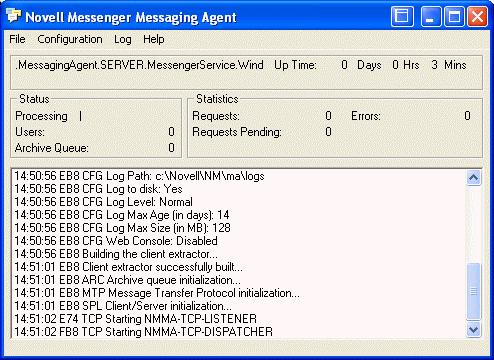
The Messaging Agent console includes several areas of information:
Table 2-3 Messaging Agent Console Information
|
Information |
Description |
|---|---|
|
Information Box |
Identifies the Messaging Agent, displays description information provided in ConsoleOne, and shows how long the Messaging Agent has been running. |
|
Status Box |
Displays the number of current Messenger client users and the number of conversations that are queued for archiving. The rotating processing bar shows that the Messaging Agent is running. |
|
Statistics Box |
Displays the number of requests that the Messaging Agent has received from Messenger clients or from the Archive Agent, along with the number of requests that it has been unable to respond to. Pending requests might indicate a need to optimize Messaging Agent performance to better serve Messenger users. |
|
Log Message Box |
Displays the same information that is being written to the Messaging Agent log file. The amount of information displayed depends on the current log settings for the Messaging Agent. See Using Messaging Agent Log Files. The information scrolls up automatically. |
Controlling the Messaging Agent from the Messaging Agent Console
You can perform the following tasks to monitor and control the Messaging Agent from the Messaging Agent console at the server where the Messaging Agent is running:
Table 2-4 Performing Messaging Agent Tasks
2.5.2 Using the Messaging Agent Web Console
The Messaging Agent Web console enables you to monitor and control the Messaging Agent from any location where you have access to a Web browser and the Internet. This provides substantially more flexible access than the Messaging Agent console, which can only be accessed from the server where the Messaging Agent is running.
Setting Up the Messaging Agent Web Console
-
In ConsoleOne, browse to and expand the MessengerService object.
-
Select the Messenger Server object to display its contents.
-
Right-click the Messaging Agent object, then click .
-
Click > .
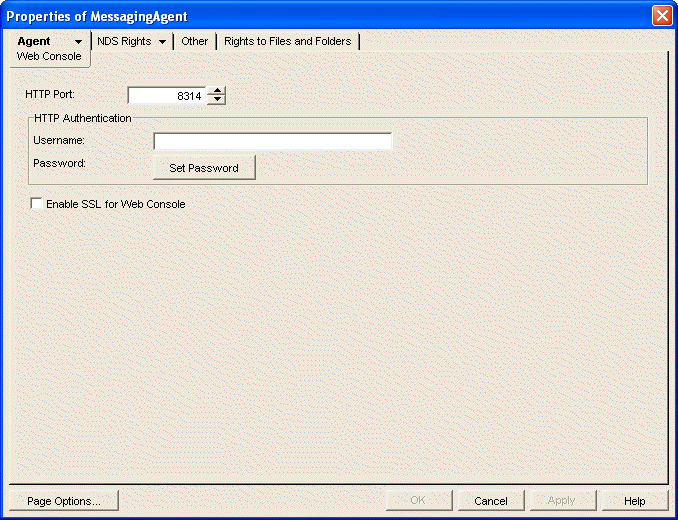
-
Fill in the following fields:
HTTP Port: Specify the port number for the Messaging Agent to listen on for service requests from your Web browser; for example, 8313.
Username: If you want to restrict access to the Messaging Agent Web console, specify a user name for the Messaging Agent to prompt for before allowing access to the Web console.
Password: Specify the password for the Messaging Agent to prompt for before allowing access to the Web console.
Enable SSL for Web Console: Select this option if you want the Messaging Agent to use SSL encryption when communicating with your Web browser.
In order to use SSL encryption for the Web console, you must properly configure the Messaging Agent, as described in Section 2.3, Establishing Messaging Security with SSL Encryption.
-
Click to save the Web console settings.
-
Stop and then start the Messaging Agent to put the HTTP settings into effect.
Corresponding Startup Switches: You can also use the /httpport, /httpuser, /httppassword, and /httpssl startup switches in the Messaging Agent startup file to enable and secure the Messaging Agent Web console.
Accessing the Messaging Agent Web Console from Your Web Browser
To monitor the Messaging Agent from your Web browser, view the following URL:
http://Messenger_server:agent_port
where Messenger_server represents the IP address or hostname of the server where the Messaging Agent is running and agent_port represents the port number you specified in Step 5 in Setting Up the Messaging Agent Web Console. For example:
http://172.16.5.18:8313
Figure 2-5 Messaging Agent Web Console Status Page
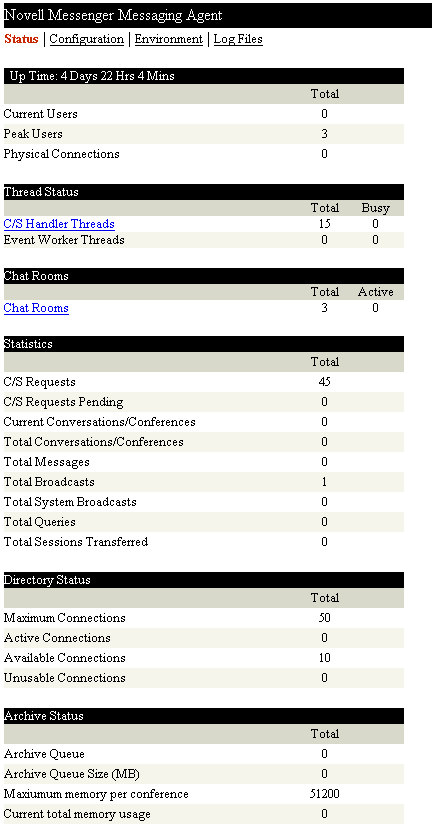
Monitoring the Messaging Agent at the Web Console
The Messaging Agent Web console provides several pages of information to help you monitor the performance of the Messaging Agent. The bar at the top of the Messaging Agent Web console displays the name of the agent. Below this bar appears the Web console menu that lists the pages of information available in the Messaging Agent Web console.
Monitoring Messaging Agent Status
When you first access the Messaging Agent Web console, the Status page is displayed.
Figure 2-6 Messaging Agent Web Console Status Page

The Web console provides more detailed status information than the Messaging Agent console.
Click to display a list of current Messenger users and their IP addresses. Click the User ID, then click to disconnect the user.
Click to display the Messaging Agent client/server threads, the number of requests each thread has handled, and each thread's current activity.
Click to display a list of current chat rooms and their CN names, owners, and number of active participants. Click to re-initialize the chat room process. By re-initializing the chat room process, chat rooms that are added in ConsoleOne are added to the list of chat rooms. Users can also use ConsoleOne to access the chat rooms after they have been added.
Checking Monitor Agent Configuration
On the Messaging Agent Web console menu, click to display Messaging Agent configuration information.
Figure 2-7 Messaging Agent Web Console Configuration Page
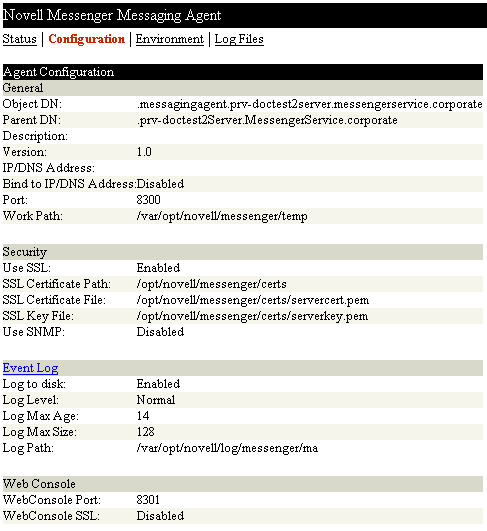
Checking the Messaging Agent Operating System Environment
On the Messaging Agent Web console menu, click to display information about the operating system where the Messaging Agent is running. On a NetWare server, the following information is displayed:
Figure 2-8 Messaging Agent Web Console Environment Page for NetWare
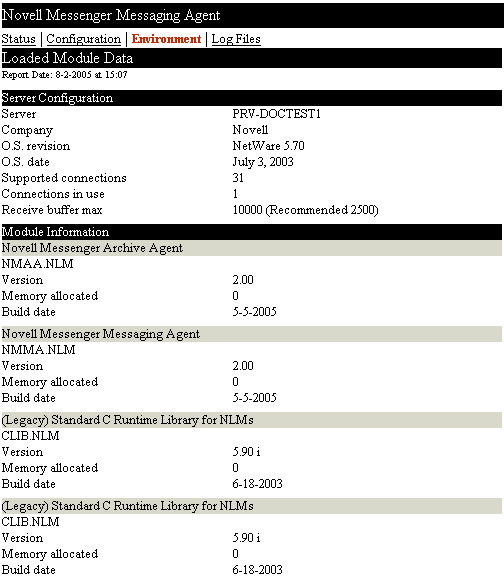
On a Linux server, the following information is displayed:
Figure 2-9 Messaging Agent Web Console Environment Page for Linux

On a Windows server, the following information is displayed:
Figure 2-10 Messaging Agent Web Console Environment Page for Windows

Viewing and Searching Messaging Agent Log Files
On the Messaging Agent Web console menu, click to display and search Messaging Agent log files.
Figure 2-11 Messaging Agent Web Console Log Files Page
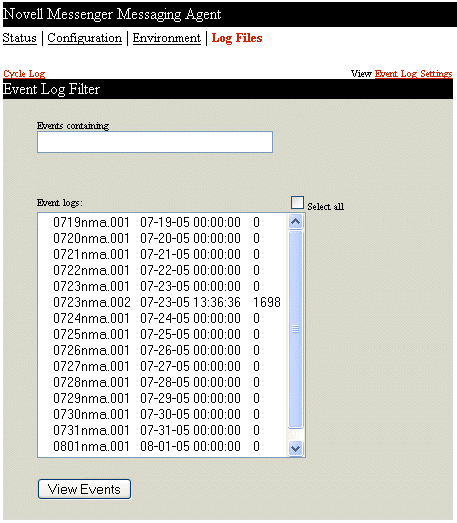
To view a particular log file, select the log file, then click .
To search all log files for a particular string, type the string in the field, select , then click . You can also manually select multiple log files to search. The results of the search are displayed on a separate page, which can be printed.
To start a new log file, click .
To view your log settings for the current Messaging Agent session, click to display the Configuration page. To change your log settings for the current Message Agent session, click on the Configuration page.
Figure 2-12 Message Agent Web Console Event Log Settings Page
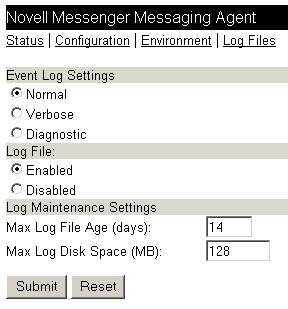
Accessing the Messaging Agent Web Console from GroupWise Monitor
If you use GroupWise Monitor to monitor your GroupWise agents, you can add the Messaging Agent to the list of monitored agents. Continue with Using GroupWise Monitor.
2.5.3 Using Messaging Agent Log Files
Error messages and other information about Messaging Agent functioning are written to log files as well as displaying on the Messaging Agent console. Log files can provide a wealth of information for resolving problems with Messaging Agent functioning.
-
In ConsoleOne, browse to and expand the MessengerService object.
-
Select the Messenger Server object.
-
Right-click the Messaging Agent, then click .
-
Click > .
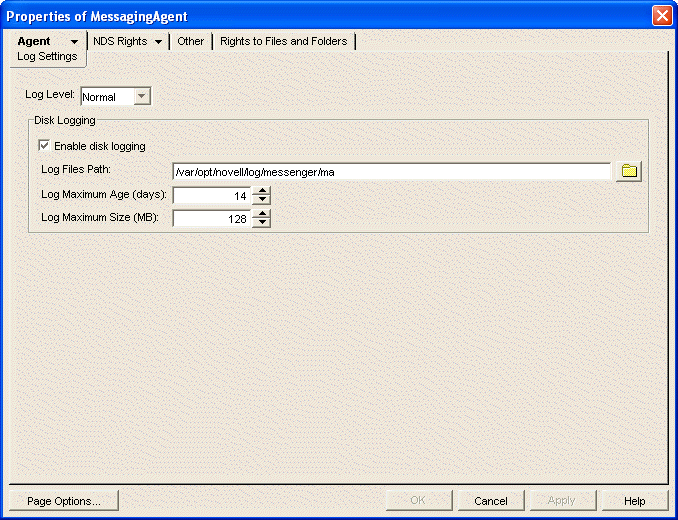
-
Fill in the following fields:
Log Level: Controls the amount of information logged by the Messaging Agent. Logged information is displayed in the log message box and written to the Messaging Agent log file during the current agent session. The default is Normal, which displays only the essential information suitable for a smoothly running Messaging Agent. Use Verbose to display the essential information, plus additional information helpful for troubleshooting. Use Diagnostic where very detailed, code-specific information is required.
Enable disk logging: Select this option so that the information displayed in the message log box at the Messaging Agent console is also saved to disk in log files.
Log Files Path: Specify the directory where the Messaging Agent stores its log files. On NetWare and Windows, the default location is the logs subdirectory of the Messaging Agent installation directory. On Linux, the default location is /var/opt/novell/log/messenger/ma.
Typically you find multiple log files in the specified directory. The first four characters represent the date. The next three identify the agent. A three-digit extension allows for multiple log files created on the same day. For example, a log file named 0518nma.001 indicates that it is a Messaging Agent log file, created on May 18. If you restarted the Messaging Agent on the same day, a new log file started, named 0518nma.002.
Log Maximum Age: Specify how many days to keep Messaging Agent log files on disk. The default is 14 days.
Log Maximum Size: Specify the maximum amount of disk space for all Messaging Agent log files. When the specified disk space is consumed, the Messaging Agent deletes existing log files, starting with the oldest. The default is 128 MB.
-
Click to save the log file settings.
-
Stop and then start the Messaging Agent to put the new log settings into effect.
2.5.4 Using GroupWise Monitor
GroupWise Monitor can be configured to monitor the Messaging Agent as well as the GroupWise Agents (Post Office Agent, Message Transfer Agent, Internet Agent, and WebAccess Agent). For background information about GroupWise Monitor, see Monitor
in the GroupWise 8 Administration Guide.
-
Enable the Messaging Agent Web console, as described in Setting Up the Messaging Agent Web Console
-
At the Windows Monitor Agent console, click > .
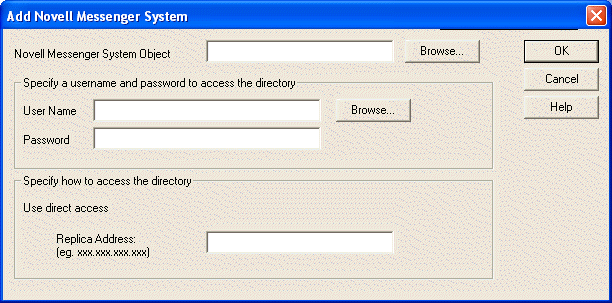
-
Fill in the following fields:
Novell Messenger System Object: Browse to and select the MessengerService object.
User Name: Browse to and select a User object that has sufficient rights to enable the Monitor Agent to access Messenger agent object properties in eDirectory.
Password: Specify the eDirectory password associated with the selected User object.
-
Provide the same eDirectory access information as you provided during installation:
Use Direct Access: Select this option if the Messaging Agent uses direct access to eDirectory.
-
Replica Address: If the Messaging Agent is installed on a Windows server, provide the IP address of a server where the Messaging Agent can access a replica of eDirectory. If the Messaging Agent is installed on a NetWare server, you do not need to specify this information because there is an eDirectory replica on the NetWare server
-
-
Click to save the information about your Messenger system.
The Messaging Agent appears in the root agent group, along with the Archive Agent if it is running on the same server. You might want to create an agent group specifically for the Messenger agents. See
Creating and Managing Agent Groups
inMonitor
in the GroupWise 8 Administration Guide.
2.5.5 Using Novell 6.5 Remote Manager
If the Messaging Agent is running on a NetWare 6.5 server, you can use the IP Address Management feature in Novell Remote Manager ( > > ) to view the IP address and port configuration for the Messaging Agent. This is also true for the Archive Agent running on a NetWare 6.5 server.
You access Novell Remote Manager by entering the following URL in a Web browser:
http://server_address:8008
For example:
http://192.168.0.0:8008
For more information about using Novell Remote Manager, see the NetWare 6.5 documentation.
2.5.6 Using SNMP Monitoring Programs
You can monitor the Messaging Agent from the Management and Monitoring component of Novell ZENworks for Servers, ManageWise, or any other SNMP management and monitoring program. When properly configured, the Messaging Agent sends SNMP traps to network management consoles for display along with other SNMP monitored programs. It also responds to requests for configuration and status information from SNMP management and monitoring programs.
Although the Messaging Agent is SNMP-enabled by default, the server where the Messaging Agent is installed must be properly configured to support SNMP, and the Messaging Agent object in eDirectory must be properly configured as well. To set up SNMP services for your Messenger server, complete the following tasks:
Setting Up SNMP Services for the Messaging Agent
Select the instructions for the platform where the Messaging Agent runs:
Setting Up SNMP Services on a NetWare Server
The Messaging Agent supports SNMP through the SNMP services loaded on the NetWare server. SNMP services are provided through the SNMP NLM. The SNMP NLM initiates and responds to requests for monitoring information and generates trap messages.
If the SNMP NLM is not loaded before the Messaging Agent, Messaging Agent still loads and functions normally, but SNMP support is disabled. The Messaging Agent does not attempt to auto-load snmp.nlm.
-
Go to the console of the NetWare server where you want to implement SNMP services.
The server should already have the Messenger agents installed.
-
Enter the command to load the SNMP NLM:
Syntax: load snmp v control=x monitor=y trap=z
where v represents Verbose, meaning to display informational messages, and x, y and z are replaced with your system SNMP community strings for SNMP SETs, GETs and TRAPs.
Example: load snmp v control=private monitor=public trap=all
The TCP/IP NLM automatically loads snmp.nlm, using default values for the community strings. If your system uses different community string values, load snmp.nlm before tcpip.nlm.
If the SNMP NLM is already loaded, you can add the control and trap parameters by entering the following at the console prompt:
snmp control= trap=
-
To automatically load these commands, include them in the autoexec.ncf file.
For more information about implementing SNMP services, see your NetWare documentation.
Setting Up SNMP Services on a Linux Server
The Linux Messaging Agent is compatible with NET-SNMP. An older version of SNMP called UCD-SNMP cannot be used with the Linux Messaging Agent. NET-SNMP comes with the versions of Red Hat Linux supported for Messenger 1.0 for Linux, but it does not come with the supported versions of SUSE Linux. If you are using SUSE Linux, you must update to NET-SNMP in order to use SNMP to monitor the Linux Messaging Agent.
-
Make sure you are logged in as root.
-
If NET-SNMP is not already set up on your Linux server, use the following command to configure SNMP:
snmpconf -g basic_setup
The snmpconf command creates the snmpd.conf file in one of the following directories, depending on your version of Linux:
/usr/share/snmp /usr/local/share/snmp ~/.snmp
-
Locate the snmpd.conf file on your Linux server.
-
In a text editor, modify the snmpd.conf file:
-
Add the following line:
dlmod Nmweb /opt/novell/messenger/lib/libnmsnmp.so.1
-
Save and exit the snmpd.conf file.
-
-
Restart the SNMP daemon (snmpd) to put the changes into effect.
-
In a text editor, modify the nmsnmp.conf file in the /etc/opt/novell/messenger directory:
-
Set /daemonPort to a unique port number for the Messaging Agent to listen on; for example, 8305.
-
If you have not already configured the Messaging Agent Web console, as described in Setting Up the Messaging Agent Web Console, assign an HTTP port for the Messaging Agent.
You can set the HTTP port in ConsoleOne, using the same steps as for setting up the Web console, or you can set /maPort to a unique port number, such as 8301. If you want to use SNMP with the Archive Agent, you can also provide an HTTP port for it by using /aaPort if you update the nmsnmp.conf file, rather than providing the settings in ConsoleOne.
-
Save and exit the nmsnmp.conf file.
-
-
In ConsoleOne, enable SNMP:
-
Browse to and right-click the Messenger Server object, then click .
-
Click > .
-
Select .
-
Click to save the setting.
-
-
Restart the Messaging Agent.
Setting Up SNMP Services on a Windows Server
The SNMP service is usually not included during the initial Windows operating system installation. The SNMP service can be easily added at any time. To add or configure the SNMP service, you must be logged in as a member of the Administrator group.
To add the SNMP service to a Windows 2000 server:
-
From the Control Panel, double-click .
-
Click .
-
Select .
-
Click , then select .
For more information about configuring the SNMP service, see your Windows 2000 documentation.
The Messenger Installation program includes an option for installing SNMP support. However, if the Windows server where you installed the Messaging Agent did not yet have SNMP set up, that installation option was not available. Now that you have set up SNMP, you can install Messaging Agent SNMP support.
Rerun the Messenger Installation program, using the Install Server option as described in the Novell Messenger 2.1 Installation Guide, noticing that the Install and Configure SNMP for the Messenger Agents option is now available and selected.
Figure 2-13 Server Information Dialog Box With the SNMP Option Selected
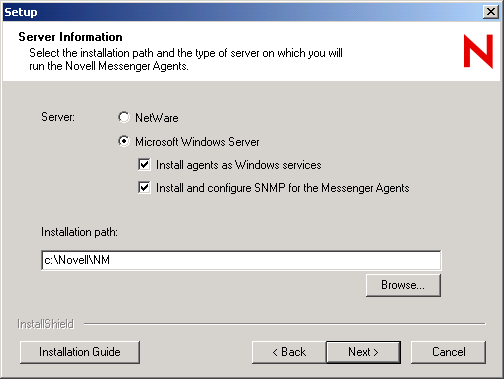
When you have finished installing the Messenger Agent, continue with Copying and Compiling the Messaging Agent MIB File.
Copying and Compiling the Messaging Agent MIB File
An SNMP-enabled Messaging Agent returns information contained in a Management Information Base (MIB). The MIB is an ASCII data structure that defines the information gathered. It also defines the properties that can be monitored and managed on the SNMP-enabled Messaging Agent.
Before you can monitor an SNMP-enabled Messaging Agent, you must compile the nmma.mib file by using your SNMP management program. On NetWare and Windows, the Messenger agent MIBs are located in the downloaded Novell Messenger 2.1 image in the \server\snmp directory. On Linux, the Messenger MIBs are located in the /etc/opt/novell/messenger/mibs directory after installation.
-
Copy the nmma.mib file to the location required by your SNMP management program.
For example, ManageWise users would copy the nmma.mib file to the \mw\nms\snmpmibs\current directory. ZENworks for Servers users can access the nmma.mib file in the downloaded Novell Messenger 2.1 image.
-
Compile or import the nmma.mib file as required by your SNMP management program.
For example, to compile the nmma.mib file for ZENworks for Servers:
-
In ConsoleOne, right-click the Site Server object, then click > .
-
Click > .
-
Browse to and select the nmma.mib file, then click .
-
Click .
-
Make sure that the server where the Messaging Agent is running is configured to send SNMP traps to the ZfS Site Server.
-
On a NetWare server, add the IP address or hostname of the ZfS Site Server to the traptarg.cfg file in the sys:\etc directory.
-
On a Windows server, add the IP address or hostname of the ZfS Site Server to the list of trap destinations. From the Windows 2000 Control Panel, double-click , then click > > > .
Refer to your SNMP management program documentation for specific instructions.
-
-
-
If you are using ManageWise, continue with Customizing Your ManageWise Installation to Monitor the Messaging Agent.
or
If you are not using ManageWise, skip to Configuring the Messaging Agent for SNMP Monitoring.
Customizing Your ManageWise Installation to Monitor the Messaging Agent
The downloaded Novell Messenger 2.1 image includes a file that helps ManageWise monitor the Messenger agents more effectively. These capabilities are available only with ManageWise, not with ZENworks for Servers.
The nmma.mib file includes the standard SNMP management information. In addition, the file includes annotations that enhance the Alert functions of ManageWise.
For example, the Summary provides more detailed information than the Description does in other SNMP management programs. The ManageWise annotations are embedded in comments; therefore, they have no affect on other SNMP management programs
When Messaging Agent alarms appear in ManageWise, you can double-click the alarm to display the alarm information contained in the Messenger Alarm help file. To enable this feature, copy the nmalarm.hlp file from the \server\snmp directory in the downloaded Novell Messenger 2.1 image to the \mw\nms\help directory on your ManageWise station. This help file explains the alarms the Messaging Agent might produce by giving a description, cause, and action for each alarm.
Configuring the Messaging Agent for SNMP Monitoring
In order for SNMP monitoring programs to monitor the Messaging Agent, the Messaging Agent must be configured with an SNMP community string.
-
In ConsoleOne, browse to and expand the MessengerService object.
-
Right-click the Messenger Server object, then click .
-
Click > .
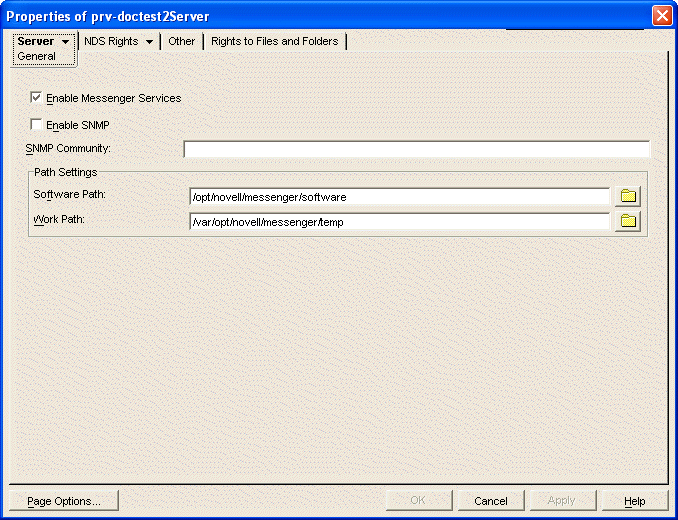
-
Make sure that is selected.
-
In the field, provide your system SNMP community GET string.
-
Click to save the SNMP settings.
-
Stop and then start the Messaging Agent to put the SNMP settings into effect.